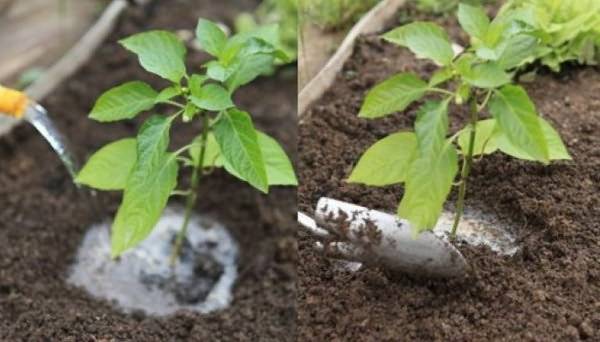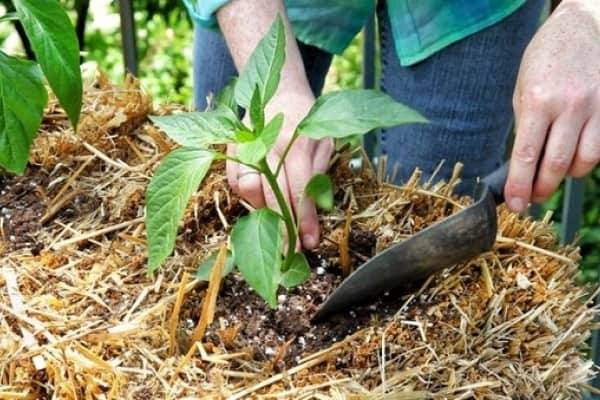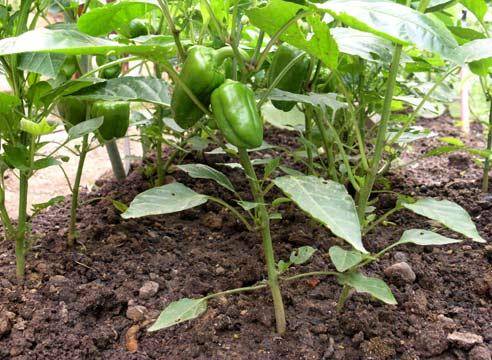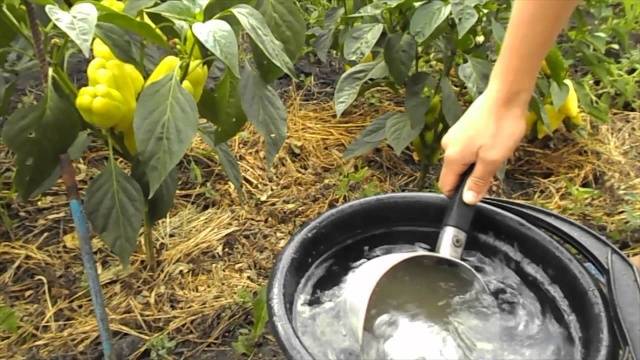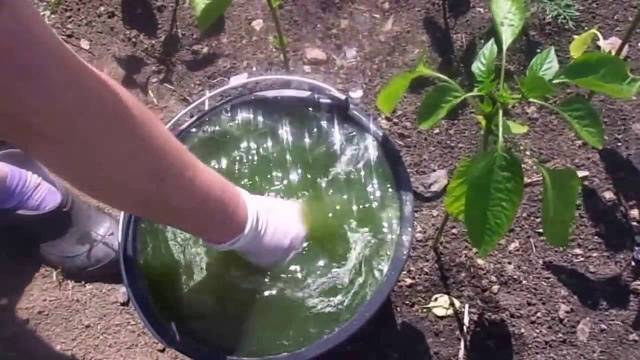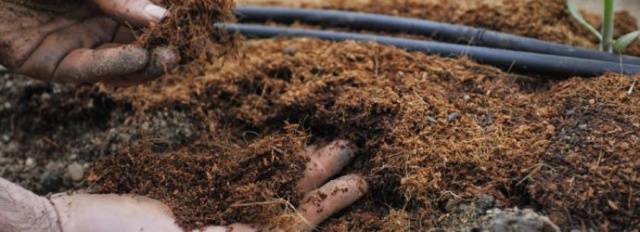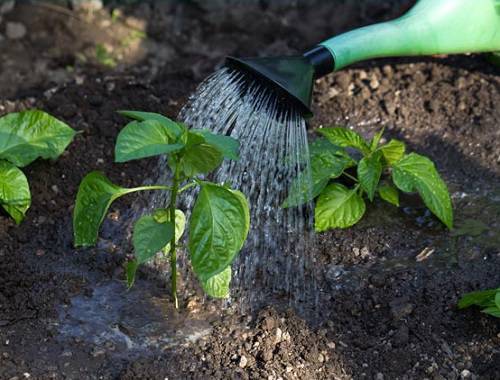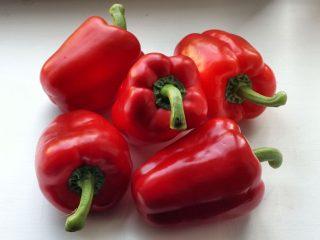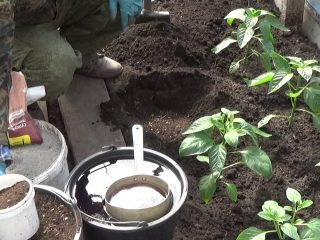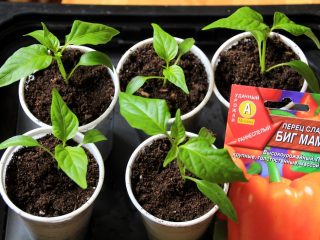Content
Pepper is one of those vegetables that are most often found in gardens. It may not seem so easy to grow. Regardless of where this vegetable crop is grown, whether in open ground or in a greenhouse, it needs proper care and regular feeding. Peppers grown in this way will be strong and healthy, and most importantly, they will give a very generous harvest. In this regard, the question arises - how to feed peppers after planting in the ground? In this article we will look at what fertilizers Use at different stages of pepper growth. We will also see how caring for peppers in a greenhouse and in open ground differs.
How to plant in the ground
Transplanting pepper seedlings into the ground begins in the last week of May. At this stage of growth, the sprout should have at least 10 leaves, and possibly a couple of flowers. At first, it is better to place the pepper under cover, especially if May turned out to be cold. You can build such a shelter with your own hands from scrap materials.For example, some people install metal or wood rods in an arc over a bed of peppers. Then they are covered on top with film or other material. The film should not be secured too securely so that the seedlings can be ventilated in the future.
It is also necessary to prepare the soil before planting. Nitroammophosphate and compost are added to it. Then holes are made in the soil. They should be 30 cm apart and 60 cm between rows. A large amount of water is poured into the prepared holes. You can also add just a little potassium permanganate to the water. We place pepper seedlings into the holes and fill them with soil. The soil around the seedlings must be lightly compacted.
Caring for peppers after planting
The first feeding is carried out 2 weeks after planting in open ground. At this stage, the pepper can be fertilized with mullein solution. At the end of June, the period of flowering and active growth of bushes begins. At this time, pepper especially needs feeding. Ordinary wood ash is suitable for these purposes. You can immediately dilute it with water and water it, or sprinkle it on the bushes, and then water the plants. After another three weeks, it is recommended to fertilize with mineral fertilizers containing potassium and calcium. After the ovaries are formed, it is necessary to cut off underdeveloped and small fruits. This way, the remaining peppers will grow larger and stronger.
All care for peppers after planting consists of the following steps:
- pepper seedlings need abundant and regular watering;
- peppers should not overheat in the sun;
- the soil must be loosened so that moisture flows freely to the root system of the plants;
- fertilizers based on calcium and potassium will help seedlings have higher resistance to various diseases. Their use is mandatory;
- to retain moisture and nutrients in the soil, it is advisable to mulch the rows;
- if the peppers are under cover, then the thickness of the film should vary depending on weather conditions. The greenhouse or shelter must be ventilated regularly;
- Peppers cannot be planted in one place for 2 years in a row.
Fertilizing peppers in a greenhouse
Even before planting seedlings, it is necessary to properly prepare the soil. The soil for growing peppers should be loose, moist and well heated. Carrots and onions are good predecessors for this vegetable.
Priming in a greenhouse or greenhouse Before planting, peppers should be fertilized with compost or rotted manure. If you do not have such an organic fertilizer, then you can pick up fertilizers with similar effects in specialized stores.
The next subcortex is carried out only one and a half or two weeks after planting the seedlings in the ground. The third feeding is done during the period of fruit formation on the bushes. It is advisable to carry out additional fertilizing of the soil in the greenhouse. For example, if you see the plants need some microelements or when the seedlings are sick. The appearance of the plants will tell you when and what it needs.
The following signs may indicate a lack of microelements:
- If the lower leaves become purple in color, it means that the seedlings do not have enough phosphorus.
- Grayish and dull leaves indicate nitrogen deficiency.
- The presence of dry leaves may indicate that the pepper is in need of potassium.
Each of these microelements is responsible for a specific process in the growth and development of pepper. So you can achieve a good result only by using them all as needed. By monitoring the growth and appearance of the seedlings, this will not be difficult.
You can also add additional organic matter. In this matter, you should be careful not to overdo it. Excess organic matter can negatively affect peppers. But a moderate amount of fertilizer will never be superfluous. Pepper seedlings respond very well to carbon. To saturate the air in the greenhouse with it, you will need to install a special tank. It rots the manure and releases carbon into the air. To do this, the tank is half filled with manure and half with water at room temperature. Such additional feeding will give strength to the seedlings and help to form strong and healthy shoots.
If the seedlings develop poorly, you can help them with fertilizers. In this case, it is better not to use organic matter, especially manure, as it can burn the plants. But if it is not possible to add mineral complexes, then you can use wood ash or nettle infusion for feeding. Nitrogen or phosphorus are perfect for these purposes. Nitrogen has a positive effect on the growth and formation of a strong root system. Nitrogen has a good effect on leaves and ovary formation.
Feeding pepper depending on growth
Above we looked at the standard set of fertilizers for sweet bell peppers. But do not forget that the composition of the feed directly depends on the age of the seedlings. The growth process is affected by weather conditions and soil composition. Therefore, the need of bushes for microelements may differ. Some growth characteristics also depend on the specific pepper variety. In cloudy weather, it is necessary to apply fertilizers that contain potassium. In such conditions, peppers will need 20% more potassium than in warm, sunny weather.
It must be remembered that fertilizers from each group act differently on pepper seedlings. Mineral fertilizing can increase the growth rate of pepper. While organic fertilizers have a good effect directly on the fruits themselves and their quality. Thanks to organic matter, you can significantly increase the amount of harvest. To do this, use feed that includes mullein or bird droppings.
It happens that pepper grows rapidly, a large number of leaves appear on it, but there are no flowers. In this case, you should stop adding nitrogen as a feed. It would be better to use a superphosphate solution. The nutritional mixture can be prepared by combining the following components:
- 2 teaspoons of urea;
- 2 teaspoons superphosphate;
- 10 liters of water.
All ingredients are thoroughly mixed. This solution is used for watering peppers as a fertilization stimulant.
Pepper seedlings growing in greenhouse conditions require more microelements than pepper in open ground. Regular and timely feeding will help grow strong and healthy peppers. It must be remembered that during the growing season, pepper needs the following elements:
- Nitrogen.Plays an important role in the growth and formation of fruits.
- Calcium. Important for stem growth and also during fruit ripening.
- Phosphorus. Necessary for good fruiting.
- Potassium. Required for grafting bushes and fruit formation.
Feeding peppers in a greenhouse in spring
Growing sweet peppers in greenhouses is very common, because in most regions of the country it is very difficult to grow good peppers in open ground. Therefore, it is necessary to know how to properly care for peppers in such conditions.
Healthy seedlings at the beginning of growth must form a large number of ovaries. In the future, they will gradually be fertilized and form fruits. After planting seedlings, peppers especially need fertilizing with mineral fertilizers. Gardeners often use ash for the first feeding. It has an excellent antifungal effect. Can combat the most common pepper disease, blackleg.
During the first stages of growth, peppers really need calcium. Without this important element, seedlings may begin to rot, and the ovaries will simply fall off. A lack of calcium can stunt plant growth. Burns resembling rust will appear on the leaves. If the necessary fertilizing is not applied in time, the seedlings will begin to wither and, as a result, simply dry out. A lack of magnesium can also affect the plant in a similar way. Each of the microelements is important in its own way, and if one is missing, the formation of fruits may be very delayed or may not occur at all.
Feeding peppers in summer
In summer, this vegetable needs both mineral and organic fertilizers. Mineral fertilizers are most often dissolved in liquid, and then the seedlings are watered with this solution. Some minerals are sprayed onto the leaves. You can also prepare combined fertilizers, combining organic matter with minerals. When preparing such mixtures, you need to be careful with the amount of certain substances. A solution that is too concentrated can only cause harm to plants.
Combined feeding mixtures are more suitable for fertilizing peppers in open ground. In greenhouse conditions, organic matter and mineral fertilizers are usually used separately. It is important to saturate the air with nitrogen from time to time. To do this, use manure or droppings as described above. Alternatively, you can prepare a similar fertilizer from nettles. Such a plant can be found in any summer cottage. It won't require much of your time or effort. All that needs to be done is to collect green nettles and pour boiling water over it.
Fertilizing peppers in open ground
We've sorted out growing peppers in a greenhouse. Now we need to consider how to fertilize bell pepper seedlings in open ground. Seedlings require special nutrition during the flowering period. For those who prefer organic fertilizers, the following mixture is suitable:
- one kg of manure;
- half a kilogram of bird droppings;
- a bucket of water;
- two tablespoons of superphosphate.
All components must be mixed and left to brew for 5 days. Instead of superphosphate, monophosphate or potassium sulfate is also suitable. They should be added to the solution in the amount specified in the instructions. The prepared mixture is added to water for watering pepper seedlings.For 10 liters of water you will need one liter of solution.
It is also very important to use nitrogen and phosphorus fertilizers during the flowering period. They have a positive effect on the process of fruit formation and give plants more strength during the fruiting period. To saturate the soil with calcium, you can use calcium nitrate. Based on it, a 0.2% aqueous solution is prepared. This feeding will serve as an excellent prevention of blossom end rot.
For high yields, plants need pollination by insects. You can attract them to your site using one simple method. The plants are watered from above with a special solution, which is prepared based on the following ingredients:
- 100 g granulated sugar;
- 2 g boric acid;
- 1 liter of plain water.
And during the fruiting period, it is recommended to add ash to the ground. They simply sprinkle it on the soil. For one square meter you will need two cups of wood ash. It is not necessary to carry out all the above-described fertilizing. During the entire growing season, it is recommended to fertilize the soil at least 2 times. The first time you can feed the soil with organic matter immediately 2 weeks after planting the pepper. Chicken droppings or manure are suitable for this. Ready-made complex fertilizers can be used as mineral fertilizing. They are dissolved in water according to the instructions. For each pepper bush you will need at least 1 liter of this solution. Another 2 weeks after the first feeding, you can begin the second stage. This time it is better to add fertilizers containing nitrogen to the soil. During this period, pepper needs it most of all.
Disease Prevention
All vegetable crops suffer from pests and various diseases. Peppers, for example, are often susceptible to spider mite infestations. In order to begin the fight against this small insect in time, it is necessary to carefully inspect the plants for signs of damage. In this case, white spots appear on the leaves. The mites themselves are very small, and it will be quite difficult to notice them with the naked eye. They usually hide under leaves. To rid pepper seedlings of this harmful “resident”, it is necessary to spray the bushes with special agents such as derissa and malathion. To prevent the appearance of spider mites, you need to regularly water the seedlings.
No less rarely, this vegetable is attacked by aphids. Tobacco infusion can help in the fight against pests. To prepare it, you will need to infuse a mixture of 10 liters of water and 300 grams of tobacco for 3 days. This solution should be poured over the affected peppers. The product is also often used for preventive purposes.
Another option for killing pests is dandelion infusion. To prepare it, use dandelion roots or the upper parts of plants. The plant is added to warm water and infused for three hours. Plants are sprayed with this liquid. To prevent viruses, you can spray the seedlings with skim milk. This treatment is especially necessary for sprouts in the first half of the growing season.
Feeding during the fruiting period
You can determine whether the bushes need feeding during fruit ripening by the appearance of the peppers themselves. If the fruits are even and strong, and ripening occurs quickly, then the plants most likely do not require additional feeding.Fertilizers should be applied to speed up the ripening process and make it more uniform. In this case, superphosphate and potassium salt are used. Such feeding is carried out only after the first fruits have already ripened. You can also use organic fertilizers, such as manure or chicken droppings. Potassium-phosphorus fertilizers or solutions with urea are suitable as mineral fertilizers.
Feeding during slow growth of peppers
If pepper is on your site begins to wilt or lose leaves, this can only mean one thing, that the bushes lack certain microelements. Also, in rare cases, the cause may be an excess amount of minerals. In such a situation, it is necessary to carry out root and foliar feeding of peppers. The appearance of the peppers will help determine what the seedlings are missing. Matte gray leaves may indicate a lack of nitrogen in the soil. In this case, the sprouts are sprayed with a urea solution. If ovaries fall from the bushes, then the seedlings will need to be sprayed with boric acid. Poor fruit formation means that the plant has enough phosphates for me. Excessive amounts of nitrogen fertilizers may also be the cause. To eliminate the problem, it is recommended to spray with a superphosphate solution, and the amount of fertilizers that contain nitrogen will have to be reduced.
Basic Rules
When feeding peppers after planting in the ground, you need to remember a number of the most important rules:
- Planted seedlings should not be fed with large amounts of organic fertilizers.
- The bulk of mineral fertilizers are applied in the fall before plowing the soil.The next feeding is done before planting the pepper. Next, we feed the plants several times throughout the growing season.
- Nitrogen is added to the soil during the formation of ovaries. It has a positive effect on fruit formation. But an excess of this mineral can lead to the reverse process, and the peppers will ripen much later. It may also risk reducing disease resistance.
- Phosphorus in sufficient quantities significantly increases the rate of fruit ripening. In addition, it makes the roots stronger and more resistant to external factors. With a lack of phosphorus in the soil, pepper leaves turn purple.
- Potassium has a positive effect on the appearance of fruits. The peppers become brighter and more colorful. The disadvantage of this element is expressed by the fact that the edges of the leaves acquire a reddish tint.
- A lack of magnesium is manifested by the fact that young leaves begin to curl and turn yellow.
- Before you start fertilizing, it is necessary to conduct a special soil analysis to determine exactly what substances the seedlings need.
Conclusion
Planting pepper seedlings in a greenhouse or open ground is only the beginning of growing this vegetable crop. To get a rich harvest of these tasty fruits, it is necessary to enrich the soil with various organic and mineral fertilizers. Without such procedures, you can only count on small and not very beautiful peppers. But with just a little effort, you can expect great results.


